Introduction
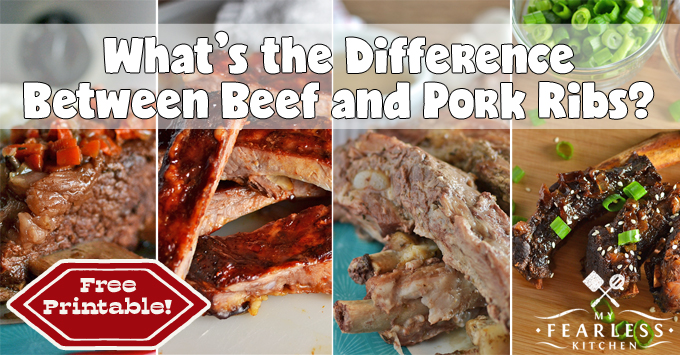
When it comes to BBQ, one of the biggest debates revolves around beef and pork ribs. These two cuts of meat both offer distinct flavors and characteristics. Choosing between beef and pork ribs ultimately comes down to personal preference and taste. Beef ribs are known for their rich and hearty flavor, while pork ribs are often loved for their slightly sweeter taste. In this article, we will explore the different types of beef and pork ribs, their flavor profiles, and the factors that contribute to their unique tastes. By the end, you’ll have a better understanding of which type of rib suits your palate.
Differentiate Between Beef And Pork Ribs
Beef and pork ribs come from different animals and have distinct characteristics. Beef ribs are taken from the rib section of cattle, while pork ribs are obtained from the rib section of pigs. The main difference lies in the flavor and texture of the meat. Beef ribs are known for their rich and intense flavor, with a denser and chewier texture. On the other hand, pork ribs have a slightly sweeter taste and a tender, fall-off-the-bone texture. The choice between beef and pork ribs ultimately comes down to personal preference and the desired flavor profile.
Factors That Influence Flavor In Ribs
Several factors can influence the flavor of ribs, whether it’s beef or pork. These include the quality and type of meat, the cooking method, the seasoning and marinades used, and even the wood or charcoal used for smoking. The quality of the meat plays a crucial role, with well-marbled beef or pork often resulting in a more flavorful and tender rib. The cooking method, whether it’s slow-smoked, grilled, or braised, also affects the taste. Additionally, the choice of seasonings, marinades, and spices can enhance the flavor of the ribs. Finally, the type of wood or charcoal used for smoking can add a distinct smoky flavor to the ribs.
Beef Ribs
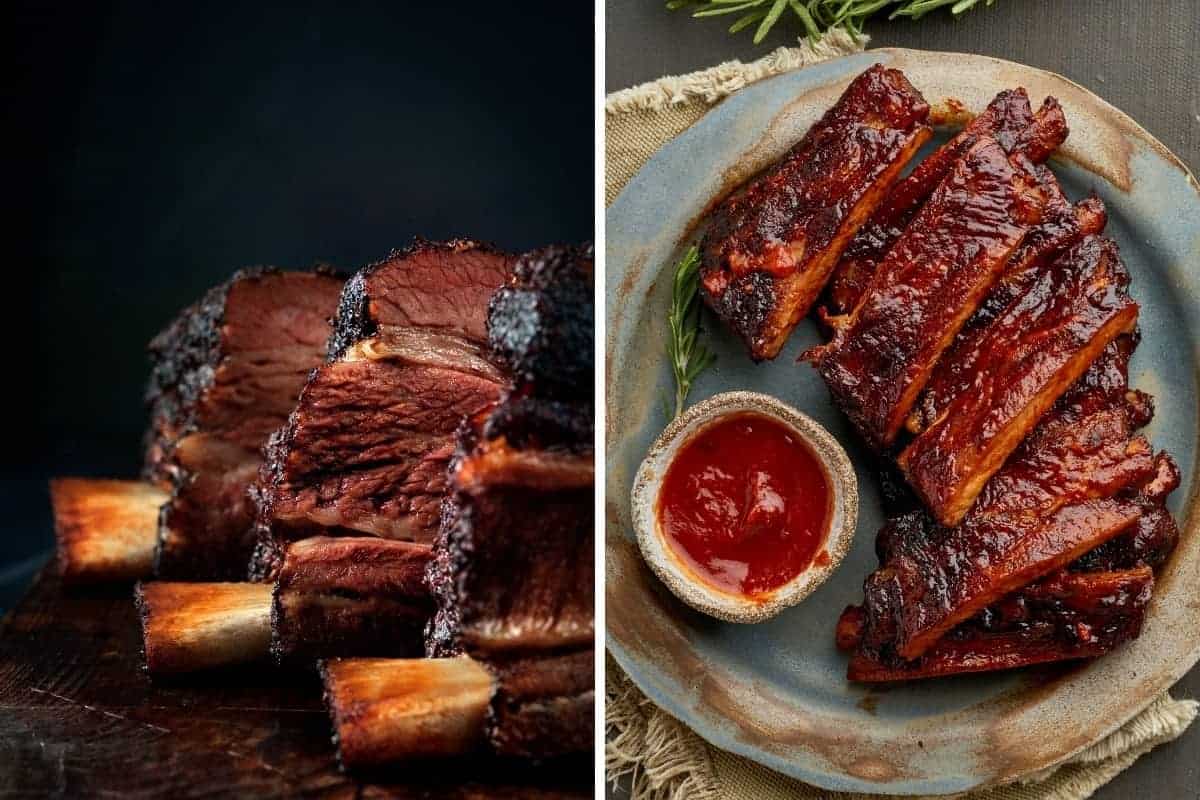
Beef ribs are a popular choice for meat lovers looking for a flavorful and tender dining experience. They come in several varieties, including short ribs and back ribs. Short ribs are known for their rich marbling, which adds to their intense beefy flavor. On the other hand, back ribs are slightly less meaty but still offer a robust taste. The quality of the meat and the cooking method used play essential roles in enhancing the flavor of beef ribs. Smoking or slow-cooking them allows the flavors to develop and gives the meat a melt-in-your-mouth texture.
Types Of Beef Ribs And Their Characteristics
There are two main types of beef ribs: short ribs and back ribs.
- Short Ribs: These are cut from the plate or brisket area of the cow, closer to the belly. They are known for their rich marbling and intense beefy flavor. Short ribs have a good amount of meat and fat, which gives them a tender and juicy texture when cooked. They are often used for braising or slow-cooking to allow the flavors to develop and the meat to become melt-in-your-mouth delicious.
- Back Ribs: Also known as beef spare ribs, these ribs are cut from the prime rib area, closer to the back of the cow. The meat on back ribs is slightly less plentiful compared to short ribs, but they still offer a robust taste. Back ribs have less marbling but are still flavorful and tender when cooked properly. They are a popular choice for grilling or smoking, allowing the smoky flavors to complement the natural beefy taste.
When choosing beef ribs, it’s important to consider your preferred level of marbling and the cooking method you plan to use.
Flavor Profile Of Beef Ribs
Beef ribs are known for their intense and robust flavor. The rich marbling and fat content in beef ribs contribute to their deep and beefy taste. When cooked properly, beef ribs are tender and juicy, with a melt-in-your-mouth texture. The flavors of beef ribs are often described as savory and hearty, with notes of umami. Additionally, the slow cooking or braising process helps to enhance and develop the natural flavors of the meat. Overall, beef ribs offer a bold and satisfying flavor profile that meat lovers can truly savor.
Pork Ribs

Pork ribs are known for their tender and juicy meat. There are several types of pork ribs, including baby back ribs, spare ribs, and St. Louis style ribs. Baby back ribs are smaller and leaner with a delicate flavor, while spare ribs are larger, fattier, and have a stronger pork flavor. St. Louis style ribs are trimmed spare ribs with the cartilage and breastbone removed. The flavor profile of pork ribs is often described as sweet and slightly smoky, making them a popular choice for barbecue lovers. Whether slow-cooked or grilled, pork ribs are a delightful treat that satisfies meat enthusiasts.
Types Of Pork Ribs And Their Characteristics
There are several types of pork ribs, each with its own unique characteristics.
- Baby Back Ribs: Also known as back ribs or loin ribs, these are smaller and leaner ribs with a delicate flavor. They come from high up on the ribs close to the spine. Baby back ribs are known for their tenderness and are often preferred for their meat-to-bone ratio.
- Spare Ribs: These ribs come from the lower part of the ribs, closer to the belly. They are larger and fattier than baby back ribs, with a stronger pork flavor. Spare ribs are known for their juiciness and are often used in barbecue recipes.
- St. Louis Style Ribs: These ribs are a slightly trimmed version of spare ribs. The cartilage and breastbone are removed, resulting in a rectangular-shaped rib. St. Louis style ribs have a good meat-to-bone ratio and a rich pork flavor. They are a popular choice for grilling and smoking.
Flavor Profile Of Pork Ribs
Pork ribs are known for their rich and distinct flavor. They have a natural sweetness that comes from the marbling of fat within the meat. The fat melts during cooking, imparting a juicy and tender texture to the ribs. Pork ribs also have a slightly gamier taste compared to beef ribs. The flavors of pork ribs can be enhanced with various seasonings and sauces, allowing for a range of taste profiles from tangy and smoky to sweet and spicy. Overall, pork ribs offer a delicious and satisfying eating experience.
Flavor Comparison
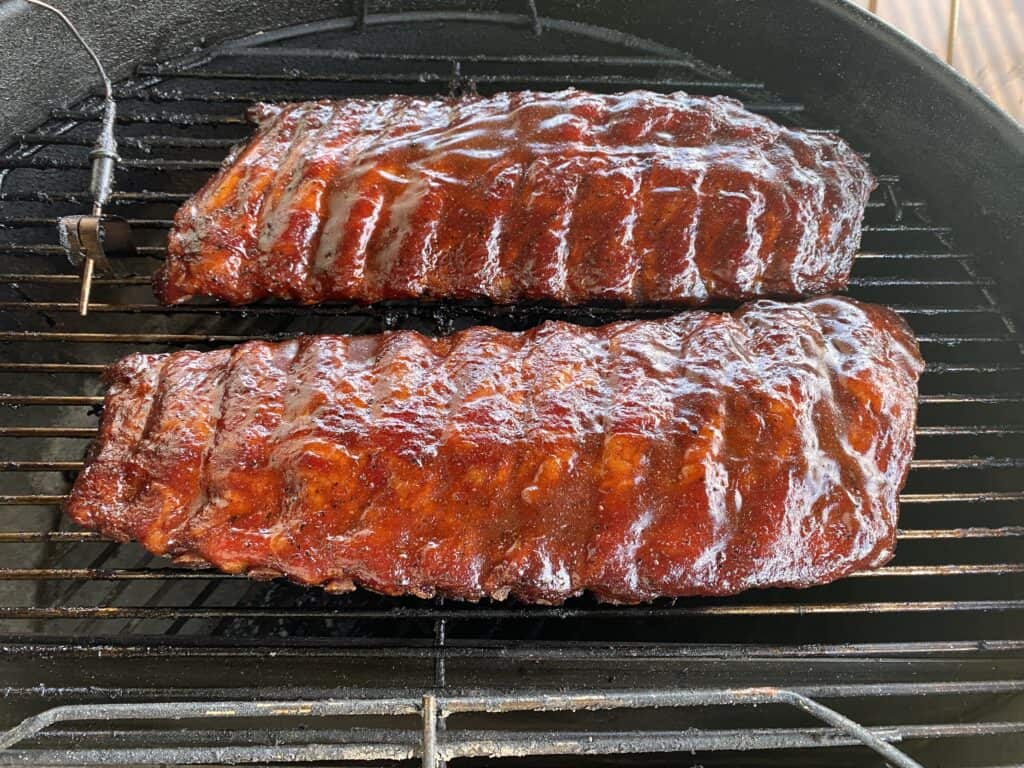
When it comes to flavor, there is a noticeable difference between beef ribs and pork ribs. Beef ribs have a robust and intense flavor that is often described as rich and beefy. They have a stronger taste and a firmer texture compared to pork ribs. On the other hand, pork ribs have a sweeter and milder flavor. The marbling of fat throughout the meat adds a natural sweetness and tenderness to pork ribs. The choice of seasoning and cooking technique can greatly influence the flavor profile of both types of ribs, allowing for endless possibilities in creating unique and delicious dishes.
Comparison Of Flavors Between Beef And Pork Ribs
When it comes to flavor, there is a noticeable difference between beef ribs and pork ribs. Beef ribs have a robust and intense flavor that is often described as rich and beefy. They have a stronger taste and a firmer texture compared to pork ribs. On the other hand, pork ribs have a sweeter and milder flavor. The marbling of fat throughout the meat adds a natural sweetness and tenderness to pork ribs. The choice of seasoning and cooking technique can greatly influence the flavor profile of both types of ribs, allowing for endless possibilities in creating unique and delicious dishes.
Factors That Contribute To The Unique Taste Of Each
There are several factors that contribute to the unique taste of beef and pork ribs.
For beef ribs, the flavor is influenced by the specific cuts of meat used, such as back ribs or short ribs. The marbling of fat throughout the beef adds richness and enhances the beefy flavor. Additionally, the cooking method and seasoning used can further enhance the taste of beef ribs.
On the other hand, the flavor of pork ribs is influenced by the type of pork used, such as baby back ribs or spare ribs. The natural sweetness of pork, combined with the marbling of fat, contributes to the tenderness and milder flavor of pork ribs. The choice of marinades and seasonings can also enhance the taste of pork ribs.
Overall, the unique taste of beef and pork ribs is a result of factors such as the type of meat, fat content, and cooking methods chosen.
Cooking Techniques
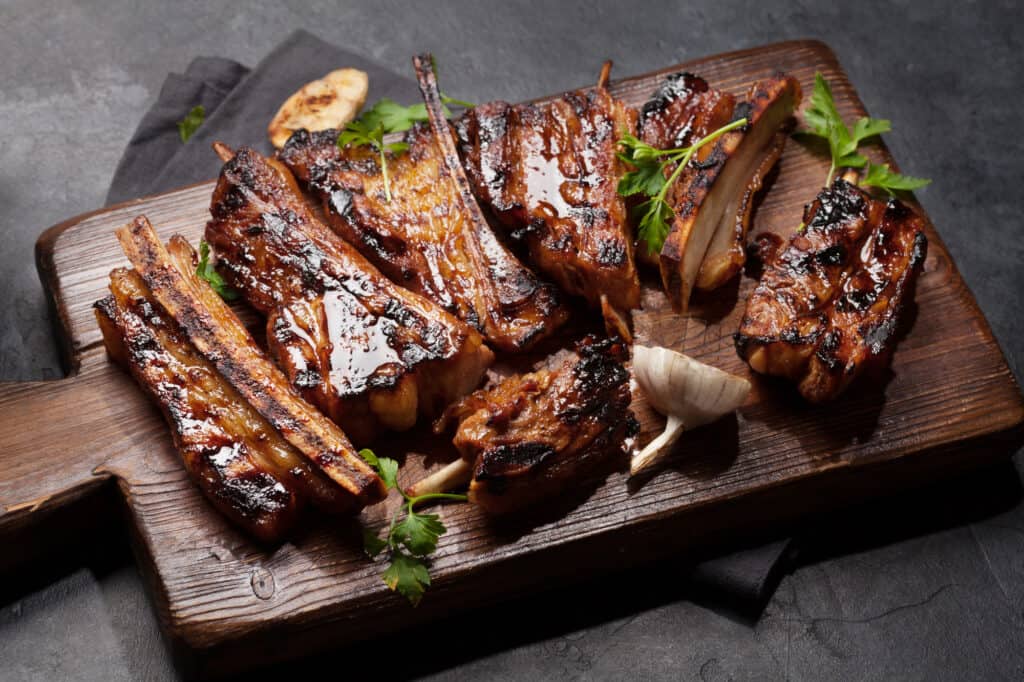
When it comes to cooking beef and pork ribs, there are different techniques that can be used to bring out their best flavors and textures. For beef ribs, smoking is often the preferred method as it allows the ribs to cook slowly, resulting in tender meat and a smoky flavor. Grilling is also a popular option for beef ribs, as it creates a crispy outer crust while maintaining a juicy interior.
On the other hand, pork ribs are best cooked using the smoking method, which imparts a delicious smoky flavor that complements the natural sweetness of the meat. Grilling pork ribs is another great technique, as it caramelizes the sauce and enhances the overall taste. Regardless of the cooking technique chosen, it’s important to ensure that the ribs are cooked thoroughly and reach the desired level of tenderness.
Best Cooking Methods For Beef Ribs
When it comes to cooking beef ribs, there are two best methods that bring out the best flavors and textures. The first is smoking, which allows the ribs to cook slowly, resulting in tender meat and a smoky flavor. Smoking gives the beef ribs a delicious, melt-in-your-mouth texture. The second method is grilling, which creates a crispy outer crust while maintaining a juicy interior. Grilling the beef ribs enhances the natural flavors and adds a hint of charred goodness. Whether you choose to smoke or grill, these cooking methods will ensure a delicious and satisfying beef rib dining experience.
Best Cooking Methods For Pork Ribs
When it comes to cooking pork ribs, there are two best methods that bring out the best flavors and textures. The first is smoking, which allows the ribs to cook slowly and absorb the smoky flavors, resulting in tender and flavorful meat. Smoking pork ribs also creates a delicious caramelized crust on the outside. The second method is slow-roasting in the oven, which helps to tenderize the meat and allows the flavors to develop. Whether you choose to smoke or slow-roast, these cooking methods will ensure mouthwatering and succulent pork ribs.
Conclusion
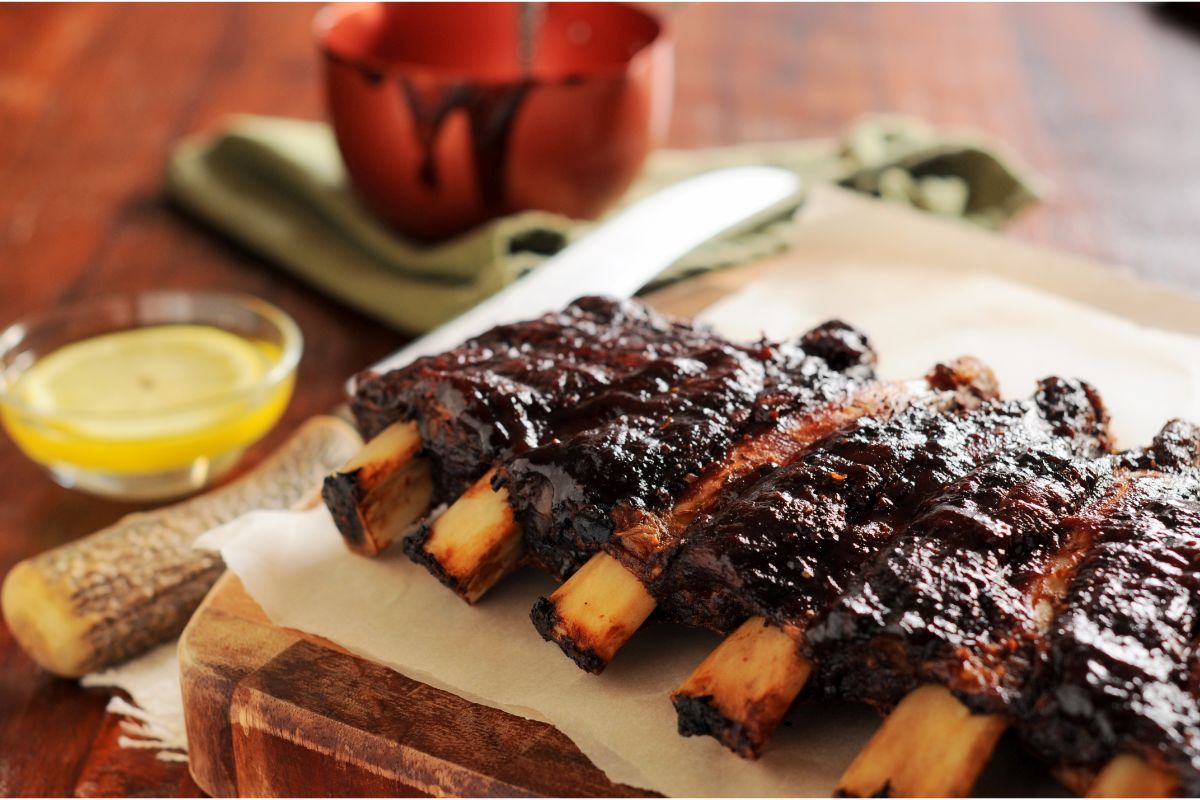
In conclusion, the battle between beef and pork ribs is a tough one to call. Both varieties offer their own unique flavors and characteristics that can satisfy any barbecue lover’s palate. When choosing between beef and pork ribs, it ultimately comes down to personal preference. Some may prefer the rich and hearty flavors of beef ribs, while others may enjoy the tender and succulent taste of pork ribs. Whatever your preference, both beef and pork ribs provide a delicious and satisfying meal that will leave you craving for more. So fire up the grill and enjoy the ultimate barbecue experience with your favorite type of ribs.
Key Factors To Consider When Choosing Between Beef And Pork Ribs
When deciding between beef and pork ribs, there are several key factors to consider. First and foremost, personal preference plays a significant role. Some individuals prefer the rich and hearty flavor of beef ribs, while others enjoy the slightly sweeter taste of pork ribs. Additionally, the cooking method can impact the flavor and tenderness of the meat. Beef ribs are typically best suited for low and slow cooking methods, while pork ribs can be prepared using various techniques such as smoking, grilling, or baking. Ultimately, it boils down to individual taste and desired cooking method.
Personal Preferences And Recommendations
When it comes to personal preferences and recommendations for choosing between beef and pork ribs, it ultimately boils down to individual taste and desired cooking method. Some people prefer the rich and hearty flavor of beef ribs, while others enjoy the slightly sweeter taste of pork ribs. If you enjoy a smokier flavor and prefer low and slow cooking methods, beef ribs may be the way to go. On the other hand, if you prefer a faster cooking time and a more tender texture, pork ribs might be your best bet. Ultimately, it’s important to experiment and find out what suits your palate and cooking style best.
FAQ: Beef vs Pork Ribs
Q: What is the main difference between beef and pork ribs?
A: The main difference lies in the type of meat. Beef ribs come from cattle, while pork ribs come from pigs. This leads to variations in flavor, texture, and cooking techniques.
Q: Which type of ribs has a richer flavor?
A: Both beef and pork ribs offer their own unique flavors. Beef ribs tend to have a more robust and intense taste, while pork ribs have a slightly sweeter and milder flavor.
Q: How does the texture of beef and pork ribs differ?
A: Beef ribs are known for their sturdy and chewy texture. They require longer cooking times to achieve tender meat. On the other hand, pork ribs have a more tender and delicate texture, making them quicker to cook to perfection.
Q: Are there any differences in the cooking methods for beef and pork ribs?
A: Yes, the cooking methods differ for beef and pork ribs. Beef ribs benefit from slow cooking methods such as smoking or braising to break down the tough connective tissues and render them tender. Pork ribs, on the other hand, can be cooked through grilling, baking, or even slow cooking methods for shorter periods.
Q: Can I use the same seasonings and sauces for both beef and pork ribs?
A: While many seasonings and sauces work well with both beef and pork ribs, there are certain differences to consider. Beef ribs pair well with bold and savory flavors like garlic, pepper, and smoky barbecue sauces. Pork ribs, on the other hand, are complemented by sweet and tangy flavors like honey, brown sugar, and fruity barbecue sauces.
Q: Which type of ribs is healthier?
A: Beef and pork ribs have different nutritional profiles. Pork ribs tend to be higher in calories and fat content, particularly if they have more visible fat or are prepared using fatty methods. Beef ribs are leaner, but still contain some levels of fat. It’s important to practice moderation and consider portion sizes when enjoying either type of ribs.
Q: Are there any cultural or regional preferences for beef or pork ribs?
A: Yes, there are cultural and regional preferences when it comes to beef and pork ribs. In the United States, pork ribs, especially baby back ribs, are immensely popular in many barbecue traditions. Beef ribs, such as beef short ribs or beef back ribs, are often favored in Texas-style barbecue. However, preferences can vary widely depending on personal taste and regional culinary traditions.
Q: Can I substitute beef ribs for pork ribs in recipes, and vice versa?
A: While it is possible to substitute beef ribs for pork ribs or vice versa in recipes, keep in mind that the flavor, texture, and cooking times may differ. It’s best to adjust your cooking techniques, seasonings, and cooking times to suit the type of rib being used.
Q: How should I store and handle beef and pork ribs?
A: It’s important to store both beef and pork ribs properly to ensure their freshness and safety. Keep them refrigerated in sealed packages or airtight containers to prevent contamination. Follow the recommended storage times and temperatures provided by your local food safety guidelines.
Q: Which type of ribs should I choose for my next meal?
A: The choice between beef and pork ribs ultimately depends on your personal preferences. Beef ribs offer a robust flavor and a chewy texture that can be enhanced with smoky seasonings or sauces. In contrast, pork ribs provide a tender meat with a slightly sweeter taste. Consider the flavor, texture, and cooking method that best suits your palate to make an informed decision.

From At-Home Dinner Parties to Family Reunions to Office Parties, we can cater your next Event!